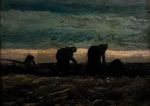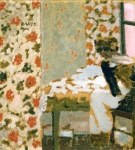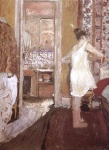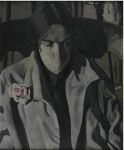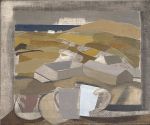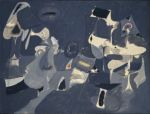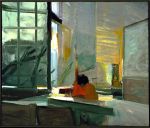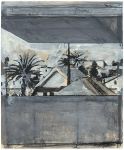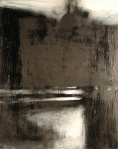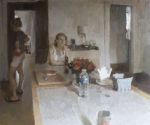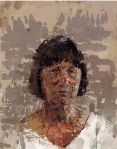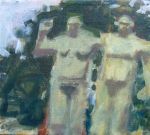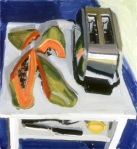Color Massing II
November 20, 2014 § 5 Comments
Describing a breakthrough he had while struggling with a landscape painting, 19th century American painter, Albert Pinkham Ryder wrote, “…the old scene presented itself…and before my eyes , framed in an opening between two trees. It stood out like a painted canvas…three solid masses of form and color: sky, foliage, and earth. The whole was bathed in an atmosphere of golden luminosity. I threw my brushes aside; they were too small for the work at hand. I squeezed out big chunks of pure, moist color, and taking my palette knife, I laid on blue, green, white, and brown in great sweeping strokes. As I worked, I saw that it was good and clean and strong. I saw nature springing into life upon my dead canvas! Exultantly I painted until the sun sank below the horizon. Then I raced around the fields like a colt let loose and literally bellowed for joy!” *
A gallery of color massings from the centuries:
*From Painters on Painting, edited by Eric Protter
Staying Neutral
March 7, 2014 § 3 Comments
Experience teaches us that limitation is the essence of creativity. Like a single flute playing in an echo chamber, the sounded notes of a few colors, a few shapes or lines set up visual resonances within the bounding space of the rectangle, multiplying complexity in unforeseen ways through their endless permutations. Using color in a limited way is a great way to explore this phenomenon. Here are some examples of works that choose to proscribe the range of color intensity, exploring the neutral zone that lies in the center of the color circle. Because of the relativity of color, the rainbow continues to assert itself but in a lowered intensity key. Color appears, not through pigmentation, but through optical relationships. Absence becomes presence.
Contemporary Figure Paintings
March 22, 2013 § Leave a comment
Every decade or so an article appears in the press proclaiming the return of the figure in art, implying that it somehow “went away.” In fact, the figure as a subject for painting never went away, and never will until the human race itself disappears. In a symposium on drawing several years ago at Randolph-Macon Womans College (now Randolph College) in Lynchburg, Virginia, I heard Janet Fish say, “Isms come and isms go, and the realists just keep painting.” (Or something to that effect.) Her statement could, I think, be applied accurately to the state of figure painting. Whatever the current obsession of the so-called art world, artists just keep painting the figure. Below is an album of some of the most compelling figure artists working today.
 Phil Geiger, figure study, oil on panel, 14″ x 10.” Collection of Frank Hobbs
Phil Geiger, figure study, oil on panel, 14″ x 10.” Collection of Frank Hobbs
Self-Portraits
March 28, 2011 § 5 Comments
Few subjects in art rival the human face and figure for psychological impact and technical difficulty. Our first clear vision in this world is that of our own mother’s face. Thereafter, the human face holds encoded meanings that become a life’s study.
In painting our own, or others’ likeness the fundamental challenge is learning to see and simplify the major and minor color shapes that the head presents to our eyes, instead of just the details of eyelashes, nostrils and lips. We may wish, in painting the head, to reveal the inner being of our sitter, but that will never happen without careful attention to the outer form. The inner and the outer are inseparable. Charles Hawthorne, the celebrated teacher of Edwin Dickinson and Hans Hoffman, relates a story about painting the portrait of a bald man, becoming fascinated by the colors he observed in the man’s head, one color spot against another, and finding later that he had accurately captured the sitter’s likeness with hardly a conscious thought as to how he was doing that. Seeing is a kind of knowledge.
Following is a gallery of artists’ self-portraits in a loosely chronological order from Rembrandt’s early self-portraits to the work of some notable contemporary painters. Every generation of artists, it seems, is similarly compelled to make its own statement of identity.
In his 63 years on earth, Rembrandt Harmenszoon Van Rijn (1606-1669) painted 88 self-portraits. He first painted himself in his twenties. They are masterful, proud, and just a bit cocky – the new kid on the block hanging out his shingle as a portrait painter. Caravaggio had already come and gone, alerting Rembrandt’s generation to the splendors and mysteries of raking light.
Rembrandt continued to use himself as a model throughout his life documenting his aging face through prosperous times and through the financial setback that beset him late in life. The body of self-portraits that he left us are a great legacy to the world. They have much to teach the aspiring painter about how light and shadow activate an image, how it sculpts the planes of the head and sets up a dialogue between form and space. Rembrandt’s self-portraits also teach us that content or meaning is not something that the painter needs to consciously program or add on. The inner state of the sitter and the outer forms are intimately involved in each other. Only the honest, attentive gaze will reveal it.
- Sofanisba Anguissola, 1532-1625
- Velazquez
- Rembrandt
- Elisabeth Vigee`-Lebrun, 1745-1852
- Joshua Reynolds
- Chardin
- Goya
- Courbet
- Degas
- Degas
- Cezanne
- Gauguin
- Matisse
- Picasso
- Marie Louise Motesiczky
- Vuillard
- Vuillard
- Vuillard
- Beckmann
- Lovis Corinth
- Lovis Corinth
- William Orpen
- Hopper
- Edwin Dickinson
- Edwin Dickinson
- Fairfield Porter
- Louisa Matthiasdottir
- Stanley Spencer
- Alfred Leslie
- Lucien Freud
- Avigdor Arikha
- Catherine Kehoe
- Catherine Kehoe
- David Campbell
- Daniel Dempsey
- Frank Hobbs
Weekly Object Painting
January 18, 2011 § 1 Comment
“The day is coming when a single carrot, freshly observed, will set off a revolution.” – Cezanne
“With an apple I will astonish Paris.” – Cezanne
“Seeing is the initial act of valuing, and the nature and infinite potential of human beings to see and to aesthetically order the world is the one pure subject of art.” – Robert Irwin, “The Hidden Structures of Art,” 1993
Some inspirations to guide your studies:
Also, check out this page from painter Catherine Kehoe’s blog, Powers of Observation:
http://picasaweb.google.com/catherinekehoe8/SomeStillLifePaintings#
























































